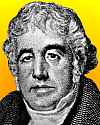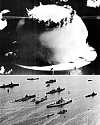
On 25 July 1843, a Scottish chemist and inventor died. He created a waterproof cloth (1823), by pressing together two rubberized layers of cloth, and his name remains associated with a particular item of waterproof clothing made from it. His name is a part of the quiz below. You probably know it, or at least his last name.
As with many inventors, this one product may be all you know of his work. Yet, as a trained chemist, he pursued various ideas in his lifetime. If you would like to extend your knowledge, you can find out more about this man in this Biography.

On 25 Jul 1920, Rosalind Franklin was born, an English scientist whose X-ray diffraction studied of DNA, led her to suspect the helical form of the molecule. When James Watson saw her photographs, he had confirmation of the double-helix form that he and Francis Crick then published. Sadly, she died of cancer, four years before the Nobel Prize was awarded to Crick and Watson, and her crucial contribution to understanding the structure of the DNA molecule remains underappreciated. Today's book pick is: Rosalind Franklin: The Dark Lady of DNA, by Brenda Maddox. The author tells a powerful story of a remarkably single-minded, forthright, and tempestuous young woman who, at the age of fifteen, decided she was going to be a scientist. Her photographs of DNA have been called “among the most beautiful X-ray photographs of any substance ever taken,” but she has been effectively airbrushed out of the greatest scientific discovery of the twentieth century. As a reader, you will likely come away bristling that Franklin should be so comparatively forgotten, but you’ll know the time you spent to learn about her gives this “Dark Lady” some recompense.
It is available from Amazon, typically about New from $8.47. Used from $1.82. (As of earlier time of writing - subject to change.)
 | It is interesting to note how many fundamental terms which the social sciences are trying to adopt from physics have as a matter of historical fact originated in the social field. Take, for instance, the notion of cause. The Greek aitia or the Latin causa was originally a purely legal term. It was taken over into physics, developed there, and in the 18th century brought back as a foreign-born kind for the adoration of the social sciences. The same is true of the concept of law of nature. Originally a strict anthropomorphic conception, it was gradually depersonalized or dehumanized in the natural sciences and then taken over by the social sciences in an effort to eliminate final causes or purposes from the study of human affairs. It is therefore not anomalous to find similar transformations in the history of such fundamental concepts of statistics as average and probability. The concept of average was developed in the Rhodian laws as to the distribution of losses in maritime risks. After astronomers began to use it in correcting their observations, it spread to other physical sciences; and the prestige which it thus acquired has given it vogue in the social field. The term probability, as its etymology indicates, originates in practical and legal considerations of probing and proving. |
 | You look at science (or at least talk of it) as some sort of demoralising invention of man, something apart from real life, and which must be cautiously guarded and kept separate from everyday existence. But science and everyday life cannot and should not be separated. |
| Before you look at today's web page, see if you can answer some of these questions about the events that happened on this day. Some of the names are very familiar. Others will likely stump you. Tickle your curiosity with these questions, then check your answers on today's web page. | |
| Births | |
 | On 25 Jul 1884, Davidson Black was born, a Canadian physician and physical anthropologist who first postulated the existence of a distinct form of early man. In 1920 he had a position at a college in China, which gave him opportunity to participate in excavations at nearby Chou K'ou-tien. Over a period of several years, as crania, mandibles, teeth, bones and tools were uncovered, Davidson examined the fossil remains. What popular name was given to the human ancestor he found? |
 | On 25 Jul 1874, Sergey Vasilyevich Lebedev was born, a Russian chemist who developed a method for industrial production of synthetic elastic rubber. He polymerized a four-carbon molecule which he derived from ethyl alcohol. Production applying his process began in the Soviet Union in 1932-33, using potatoes and limestone as raw materials. By 1940, the Soviet Union had the world’s largest synthetic rubber industry, producing over 50,000 tons per year. Which synthetic rubber polymer did Lebedev produce? |
| Deaths | |
 | A Scottish chemist and manufacturer (1766-1843) began a career in the textile industry in a cloth bleaching business. Meanwhile, trying to find uses for the waste products from gasworks, he developed a method of waterproofing cloth (1823), by pressing together two rubberized layers of cloth. His name remains associated with the raincoat made from such cloth. Can you name this man? |
 | Charles Stark Draper, an American aeronautical engineer (1901-1987) became known as the “father of inertial navigation.” Chances are, you’ve played with a toy version of the device he incorporated into systems that stablilized and balance gunsights and bombsights, and which were later expanded to an inertial guidance system for launching long-range missiles at supersonic jet targets. What was the basic device he incorporated into bombsights and his inertial guidance system? |
| Events | |
 | On 25 Jul of a certain year, a hovercraft crossed the English Channel for the first time. Having been shipped to France by tender, the world’s first all metal hovercraft, SR.N1, crossed the Channel between Calais and Dover in 2 hours 3 minutes. In which decade did this first hovercraft crossing of the English Channel take place? |
 | On 25 Jul 1909, French aviator Louis Blériot flew in a monoplane on the world’s first international overseas airplane flight. Between which two countries did he fly? |
 | On 25 Jul 1946, the U.S. detonated the “Baker” atomic bomb as its first underwater nuclear explosion. It was to test results on a naval fleet of war-surplus and captured enemy vessels. The bomb, encased in a watertight steel caisson, was suspended 90 feet below the one of the ships. The explosion created a massive column of steam and water, and a series of huge waves. After second, the first wave struck target ship Carrier Saratoga and swept it 800 yards away. It sank eight hours later. Where did this underwater atomic bomb test take place? |
Fast answers for the previous newsletter for July 24: to fly around the world (not alone, but with a navigator on board) • a surveying instrument used to measure the angle of inclination, as for slopes, elevations or heights (such as a tree) • Cambridge University • lung cancer from smoking cigarettes • the decade including the year 1950 • rotary-type printing press which rolled a cylinder over stationary plates of inked type, using the cylinder to make an impression on paper.
 If you enjoy this newsletter, the website, or wish to offer encouragement or ideas, please send feedback by using your mail reader Reply button.
If you enjoy this newsletter, the website, or wish to offer encouragement or ideas, please send feedback by using your mail reader Reply button. Your click on a Facebook, StumbleUpon, or other social button on the site webpages is also a welcome sign of appreciation. Thank you for using them.
© This newsletter is copyright 2020 by todayinsci.com. Please respect the Webmaster's wishes and do not put copies online of the Newsletter — or any Today in Science History webpage. (If you already have done so, please remove them. Thank you.) Offline use in education is encouraged such as a printout on a bulletin board, or projected for classroom viewing. Online, descriptive links to our pages are welcomed, as these will provide a reader with the most recent revisions, additions and/or corrections of a webpage. For any other copyright questions, please contact the Webmaster by using your mail reader Reply button.
--
If you do not want to receive any more newsletters, Unsubscribe
To update your preferences and to unsubscribe visit this link
Executive Real Estate Business Class
-
"It was like a man with wings. It wasn't like anything you'd see on TV or in a monster movie." ...
About the publisher
Search This Blog
Blog Archive
-
▼
2020
(1542)
-
▼
July
(200)
- PHOTOGRAPHY: The danger of documenting sharks
- Meet The Serial Killer Who Ate His Victims Because...
- The Roundup Top Ten from History News Network
- On This Day for July 31 - Lunar Roving Vehicle fir...
- Newsletter for Friday 31 July.
- Lockdowns killing more children than COVID + Docto...
- YOUR WEEKLY ESCAPE: Revisiting an iconic Nat Geo c...
- July 31: The Pilgrim Fathers Depart and the Battle...
- ANIMALS: The dog that got COVID-19
- On This Day for July 30 - Death of Otto von Bismar...
- Newsletter for Thursday 30 July.
- Frontline Docs 2nd Video Press Conf at SCOTUS We h...
- BREAKING NEWS: First U.S. dog to test positive for...
- July 30: First Defenestration of Prague, the 1st O...
- Demystified: Why Do Wolves Howl?
- The Champs Are Back on Forged in Fire Tonight
- SCIENCE: A rush to Mars during a rough patch at home
- Breaking News from History News Network
- On This Day for July 29 - National Aeronautics and...
- Newsletter for Wednesday 29 July.
- All Social Media Censor Frontline Docs COVID Video...
- July 29: Spanish Armada Scattered and Taft's Secre...
- TRAVEL: How to stay safe if you need to travel
- On This Day for July 28 - Beginning of World War I...
- Newsletter for Tuesday 28 July.
- Video Presentation from Washington Summit: America...
- July 28: Robespierre Guillotined, Austria-Hungary ...
- HISTORY: How the vice presidency became critical
- Enjoy Summer with Nat Geo Kids Magazine
- New This Week on History News Network
- On This Day for July 27 - Terrorist attack at Atla...
- Newsletter for Monday 27 July.
- COVID Propaganda & Tyrannical Edicts Affecting Men...
- July 27: Walter Raleigh Brings Tobacco, the Atlant...
- FAMILY: Can you transfer your ‘retro fun’ to your...
- The 10 greatest discoveries made by the British pu...
- On This Day for July 26 - Suez Canal seized, John ...
- Newsletter for Sunday 26 July.
- CDC says actual # of cases is up to 13X higher tha...
- July 26: 1st Muslim Civil War, Pizarro's Royal Cha...
- The Compass: Greece
- On This Day for July 25 - American advance into Ca...
- Newsletter for Saturday 25 July.
- VIRUS UPDATE: What does COVID-19 do to a child's b...
- July 25: The 1st Steam Locomotive, Mussolini Dismi...
- PHOTOGRAPHY: The photo that shocked a nation
- This Hardened Blob Of Nuclear Waste Could Kill You...
- On This Day for July 24 - Beginning of Mata Hari's...
- The Roundup Top Ten From History News Network
- Newsletter for Friday 24 July.
- Medical Journal: make the vaccine Mandatory! + Fre...
- YOUR WEEKLY ESCAPE: The man who claims to be Jesus...
- July 24: Cartier Lands in Canada, Mary Queen of Sc...
- ANIMALS: Let’s not forget this other catastrophe
- Demystified: Are Dogs Really Color-Blind?
- On This Day for July 23 - Egyptian monarchy topple...
- Newsletter for Thursday 23 July.
- listen to Dixie Brogdon Hopson tells how the hospi...
- July 23: Upper and Lower Canada United and the Bre...
- SCIENCE: The joy of vintage comforts
- A Puzzling Challenge on Forged in Fire Tonight
- Explore King Tut's tomb with National Geographic H...
- Breaking News from History News Network
- On This Day for July 22 - Deng Xiaoping reinstated...
- CDC Knows Masks and other methods don't work to st...
- Newsletter for Wednesday 22 July.
- July 22: First Congress of Vienna and Spoonerism
- TRAVEL: When tourism returns will it be better?
- Enjoy Summer with Nat Geo Kids Magazine
- On This Day for July 21 - Egyptians defeated in th...
- Newsletter for Tuesday 21 July.
- July 21: 1st Battle of Bull Run, the Trans-Siberia...
- HISTORY: John Lewis always stood for the same thing
- New This Week on History News Network
- On This Day for July 20 - First Moon landing, Sir ...
- Newsletter for Monday 20 July.
- What Scientific Study Shows 6 feet distance or "ma...
- July 20: On This Day in History
- FAMILY: Searching for patience
- Anne of Cleves: Henry VIII's most successful queen?
- On This Day for July 19 - U.S. women's suffrage mo...
- Newsletter for Sunday 19 July.
- Mask Truth Part 2, Data by Nations shows Hydroxych...
- July 19: 1st US Women's Rights Convention and V fo...
- The Compass: Colombia
- On This Day for July 18 - Publication of Mein Kamp...
- Newsletter for Saturday 18 July.
- Enough! Mask Truth, re-Creating you! the intended...
- CORONAVIRUS SPECIAL EDITION: What type of person d...
- July 18: Spanish Civil War Begins and 7 Years of K...
- PHOTOGRAPHY: Showing a nation losing its drinking ...
- How Julia Child Went From World War 2 Spy To Belov...
- Introducing Expedition: Learn! A New Way to Help K...
- The Roundup Top Ten for July 17, 2020
- On This Day for July 17 - Beginning of the Spanish...
- Newsletter for Friday 17 July.
- July 17: Execution of the Romanovs and a Stormy Bi...
- YOUR WEEKLY ESCAPE: An intimate look inside a mode...
- ANIMALS: The trouble with 'retired' chimps
- Man vs. 800-Pound Beast! Watch New Episode of Alon...
-
▼
July
(200)
-
Blogroll
-
About
HistoryFact










0 comments:
Post a Comment